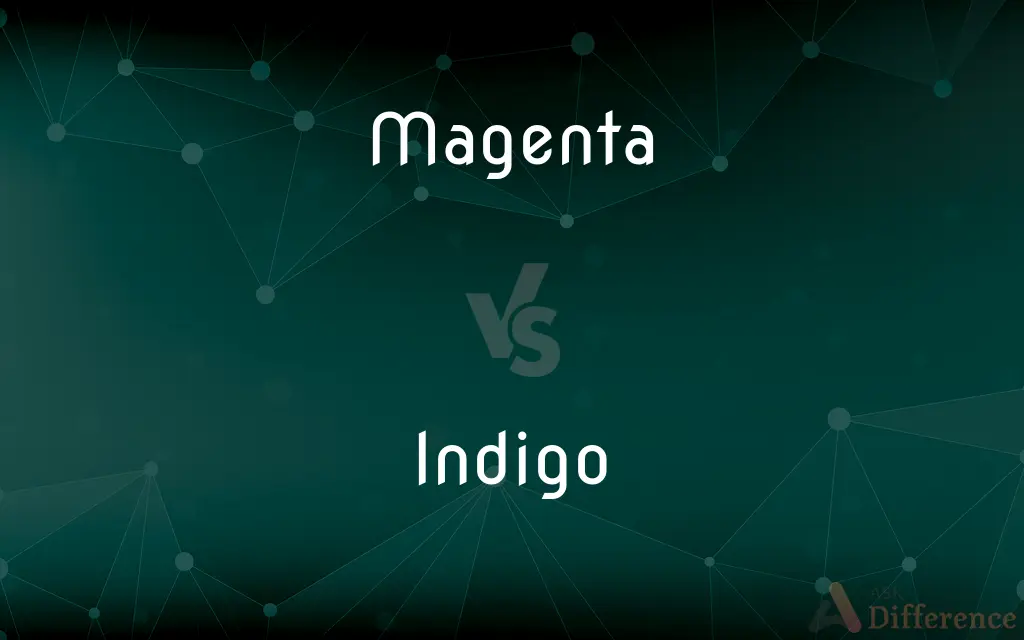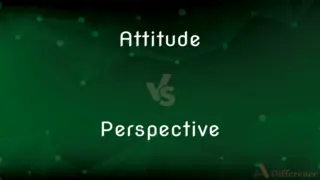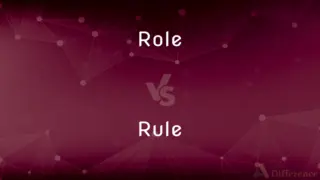Magenta vs. Indigo — What's the Difference?
Edited by Tayyaba Rehman — By Urooj Arif — Updated on March 14, 2024
Magenta is a deep, vibrant pink-purple color perceived when red and blue light combine, lacking a wavelength in the visible spectrum, while indigo is a deep blue-purple, traditionally one of the seven colors of the rainbow, closer to blue than purple.

Difference Between Magenta and Indigo
Table of Contents
ADVERTISEMENT
Key Differences
Magenta is not found as a single wavelength of light in the visible spectrum; instead, it arises in human perception when red and blue light wavelengths are present without green. This makes magenta a unique color that doesn't correspond to one specific part of the spectrum, embodying a combination that exists primarily as a perceptual phenomenon. Whereas indigo represents a specific wavelength range between 450 and 420 nanometers, closer to the violet end of the spectrum, and is recognized as one of the colors of the visible light spectrum, traditionally counted among the seven colors of the rainbow.
In terms of application, magenta is widely used in color printing, art, and design, serving as a primary color in the CMYK color model for ink and paint, where it plays a crucial role in color mixing and reproduction. On the other hand, indigo's applications are more specific, often associated with dyes and textiles, most famously the indigo dye used historically for coloring fabrics a deep blue.
Magenta can be considered a more vibrant and slightly warmer color due to its red component, often associated with creativity, vibrancy, and innovation. Indigo, being closer to blue, exudes a sense of depth, stability, and wisdom, often used in design to convey trust and serenity.
The perception of magenta as a blend of red and blue without a specific place in the spectrum highlights the complexity of human color perception, challenging the notion of color as directly tied to singular wavelengths. In contrast, indigo's place in the spectrum and its historical significance as a dye showcase the tangible connections between color, culture, and natural sciences.
Both colors have their unique places in culture and aesthetics. Magenta is seen as modern and expressive, often used in contexts that call for standout visuals. Indigo, with its rich historical roots and natural origins in the indigofera plant, carries a sense of tradition and natural beauty, favored in designs that aim for depth and thoughtfulness.
ADVERTISEMENT
Comparison Chart
Spectrum Position
Not a single wavelength; perceived through the combination of red and blue light.
Specific wavelength range (450-420 nm).
Color Model
Primary in CMYK (Cyan, Magenta, Yellow, Key/Black).
Not a primary color in standard color models.
Applications
Color printing, art, and design.
Dyes and textiles, especially traditional dyeing.
Perception
Vibrant pink-purple, perceived as warmer.
Deep blue-purple, considered closer to blue.
Cultural Associations
Creativity, innovation, vibrancy.
Depth, wisdom, stability.
Origin
Perceptual; does not correspond to a specific part of the light spectrum.
Natural; historically derived from the indigofera plant for dyeing.
Use in Design
Modern, expressive visuals.
Depth, serenity, trust.
Compare with Definitions
Magenta
A vibrant pink-purple color seen when combining red and blue light.
The sunset sky turned a stunning shade of magenta.
Indigo
A deep blue-purple color, one of the traditional seven colors of the rainbow.
The artist used shades of indigo to capture the night sky.
Magenta
Often associated with expressive and modern designs.
The designer incorporated magenta to add a vibrant, modern feel to the artwork.
Indigo
Associated with serenity and stability in design.
The indigo-colored room offers a sense of calm and stability.
Magenta
Symbolizes creativity and innovation.
They chose a magenta logo to reflect their company's innovative spirit.
Indigo
Represents depth and wisdom in color psychology.
Indigo in the branding evokes a sense of trust and depth.
Magenta
A color that challenges traditional color perception theories.
Magenta’s existence questions how we perceive colors without a single wavelength.
Indigo
Closer to blue in the spectrum.
Indigo's rich color is more reminiscent of the deep sea than of the violet flower.
Magenta
Used as a primary color in the CMYK color model.
To print that vivid flower, the printer uses a lot of magenta ink.
Indigo
Historically important as a natural dye.
Indigo dye has been valued for centuries for its rich, deep blue color.
Magenta
Magenta () is a color that is variously defined as purplish-red, reddish-purple or mauvish-crimson. On color wheels of the RGB (additive) and CMY (subtractive) color models, it is located exactly midway between red and blue.
Indigo
Indigo is a deep color close to the color wheel blue (a primary color in the RGB color space), as well as to some variants of ultramarine, based on the ancient dye of the same name. The word "indigo" comes from the Latin for Indian as the dye was originally exported to Europe from India.
Magenta
A light mauvish-crimson which is one of the primary subtractive colours, complementary to green
A short magenta dress
Bright pink double flowers each lined in dark magenta
Indigo
Any of various shrubs or herbs of the genus Indigofera in the pea family, having pinnately compound leaves and usually red or purple flowers in axillary racemes.
Magenta
See fuchsin.
Indigo
A dark blue crystalline compound, C16H10N2O2, that is obtained from these plants or produced synthetically and is widely used as a textile dye. Also called indigotin.
Magenta
A purplish red, one of the subtractive primary colors.
Indigo
Any of several related plants, especially those of the genera Amorpha and Baptisia.
Magenta
A vibrant light purple, purplish-red, reddish-purple, or pinkish purple colour obtained by mixing red and blue light (thus a secondary colour), but primary in the CMYK colour system used in printing.
Indigo
The hue of that portion of the visible spectrum lying between blue and violet, evoked in the human observer by radiant energy with wavelengths of approximately 420 to 450 nanometers; a dark blue to grayish purple blue.
Magenta
Having the colour of fuchsia, fuchsine, light purple.
Indigo
A purplish-blue colour
Magenta
An aniline dye obtained as an amorphous substance having a green bronze surface color, which dissolves to a shade of red; also, the color; - so called from Magenta, in Italy, in allusion to the battle fought there about the time the dye was discovered. Called also fuchsin, fuchsine, roseïne, etc.
Indigo
An indigo-colored dye obtained from certain plants (the indigo plant or woad), or a similar synthetic dye.
Magenta
The purplish-red color of magenta.
Indigo
An indigo plant, such as from species in genera Indigofera, Amorpha (false indigo), Baptisia (wild indigo), and Psorothamnus and Dalea (indigo bush).
Magenta
A dark purple-red; the dye was discovered in 1859, the year of the battle of Magenta
Indigo
Having a deep purplish-blue colour
Magenta
A battle in 1859 in which the French and Sardinian forces under Napoleon III defeated the Austrians under Francis Joseph I
Indigo
A kind of deep blue, one of the seven prismatic colors.
Magenta
Deep purplish red
Indigo
A blue dyestuff obtained from several plants belonging to very different genera and orders, such as, the woad, Isatis tinctoria (family Cruciferae), Indigofera suffroticosa, Indigofera tinctoria (family Leguminosae), Indigofera Anil, Nereum tinctorium, Polygonum tinctorium Ait. (family Polygonaceae), etc.; called also natural indigo. It is a dark blue earthy substance, tasteless and odorless, with a copper-violet luster when rubbed. Indigo does not exist in the plants as such, but is obtained by decomposition of the glycoside indican.
Indigo
Having the color of, pertaining to, or derived from, indigo.
Indigo
A blue dye obtained from plants or made synthetically
Indigo
Deciduous subshrub of southeastern Asia having pinnate leaves and clusters of red or purple flowers; a source of indigo dye
Indigo
A blue-violet color
Common Curiosities
How do magenta and indigo differ in the visible spectrum?
Magenta doesn't correspond to a single wavelength in the visible spectrum, existing through the perception of red and blue light combinations, while indigo occupies a specific wavelength range.
Why is magenta not found as a wavelength?
Magenta is perceived from the combination of red and blue light without a corresponding wavelength in the visible spectrum, highlighting the complexities of color perception.
How are magenta and indigo used in design?
Magenta is used for modern and expressive visuals, while indigo is chosen for designs that convey depth, serenity, and trust.
What is magenta?
Magenta is a deep, vibrant pink-purple color, resulting from the combination of red and blue light, significant in art, design, and color printing.
What is indigo?
Indigo is a deep blue-purple color, traditionally counted among the seven colors of the rainbow, known for its historical use as a dye.
What are typical applications of magenta and indigo?
Magenta is widely used in color printing and design, while indigo is traditionally used in dyes and textiles.
Can magenta and indigo be primary colors?
Magenta serves as a primary color in the CMYK color model, used in printing. Indigo does not serve as a primary color in most color models.
What makes indigo unique among colors?
Indigo's deep blue-purple hue, historical significance as a natural dye, and its specific wavelength range make it unique.
What does the presence of magenta and indigo in a palette signify?
The presence of magenta can signify a desire for vibrancy and innovation, while indigo adds depth, stability, and a sense of tradition.
How do the cultural associations of magenta and indigo differ?
Magenta is often associated with creativity, vibrancy, and innovation, whereas indigo symbolizes depth, wisdom, and stability.
Share Your Discovery

Previous Comparison
Attitude vs. Perspective
Next Comparison
Role vs. RuleAuthor Spotlight
Written by
Urooj ArifUrooj is a skilled content writer at Ask Difference, known for her exceptional ability to simplify complex topics into engaging and informative content. With a passion for research and a flair for clear, concise writing, she consistently delivers articles that resonate with our diverse audience.
Edited by
Tayyaba RehmanTayyaba Rehman is a distinguished writer, currently serving as a primary contributor to askdifference.com. As a researcher in semantics and etymology, Tayyaba's passion for the complexity of languages and their distinctions has found a perfect home on the platform. Tayyaba delves into the intricacies of language, distinguishing between commonly confused words and phrases, thereby providing clarity for readers worldwide.














































